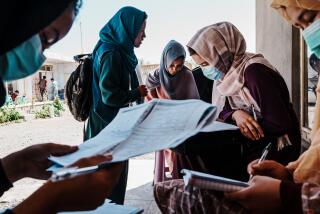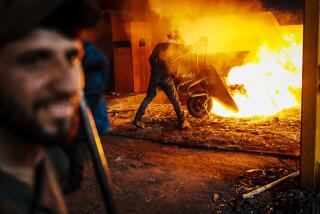Afghan Force Maintains High Profile Despite Risks
- Share via
ORGUN, Afghanistan — ORGUN, Afghanistan -- Whether they are facing Al Qaeda stragglers spoiling for a fight or power-hungry warlords firing occasional rockets at their outposts, coalition troops here are exhibiting little concern and even less inclination to lower their profile.
Smack in the exposed heart of a scorching ochre plain ringed by rugged mountains, the small compound only one ridge away from terrorist-infiltrated tribal areas of Pakistan defiantly flies the Stars and Stripes on one flagpole and the red, black and green Afghan banner on another.
This dusty, brush-choked U.S. base in southeastern Afghanistan forms a front line for the war’s new focus: destroying cached weapons, tracking enemy movements along the border and fostering the peace taking root apace with the sprouting grain fields and replanted orchards.
Still, bringing tranquillity to this most troubled corner of Afghanistan is a work in progress. Coalition officers at Bagram air base on Wednesday disclosed the discovery of two more hidden supplies of armaments, including more than 2 million rounds of ammunition, in a hillside cave with a bird’s-eye view of the U.S. operations here.
Some of the munitions stashed in caves and culverts throughout the country are being used with apparent intent to intimidate the U.S.-led forces. At least six rocket attacks have been logged here, at the nearby Khowst airfield and across the border in the Pakistani town of Miram Shah, another U.S. Special Forces venue, since enemy fighters retreated in March to their mountain strongholds on the border after Operation Anaconda.
The U.S. compound here is little more than a stone house, a few outbuildings and a sprawling tent village inside a waist-high enclosure of barbed wire. The understated defenses and the calm, if secretive, demeanor of its forces suggest a low assessment of the risks from an occasional missile.
No one has been hurt nor any property damaged, but the potshots have irritated U.S. commanders to the point of their ordering a recent special search-and-attack mission.
That operation here in Paktika and adjacent Paktia provinces failed to flush out any suspected terrorists or even to halt their fire. But a thorough combing of the surrounding high ground did chase the enemy away from the best vantage points, U.S. soldiers say.
“There was firing around us, but we weren’t able to figure out if they were targeting us or local fighters in the area,” Capt. Patrick Harkins said of the effort by troops of the 101st Airborne Division to hunt down those shooting at U.S. forces in the region.
Coalition officers insist that Al Qaeda and Taliban remnants remain active in the volatile southeastern provinces that share a border with the lawless tribal areas. But regional rivalries and pockets of resistance to the rule of interim Afghan Prime Minister Hamid Karzai also may be fomenting aggression.
Warlord Bacha Khan, the ousted Paktia leader locked in battle with his Karzai-appointed successor, Taj Mohamad Wardak, rained 500 bombs on nearby Gardez late last month in a deadly gambit to stay in power. Karzai hinted Tuesday that he may ask the U.S. troops here for assistance in quelling the warlord.
U.S. officials, though, say intervening in local conflicts exceeds their role.
“Our mandate is to capture or kill Al Qaeda terrorists and senior Taliban who supported them,” said U.S. Army Maj. Bryan Hilferty, spokesman for the coalition’s 17,000-strong Afghan deployment. While also expected to help the Karzai government get a rein on a society racked by decades of violence, the coalition is “generally not” inclined to take sides, he said.
Those plotting the endgame of the mission to deny safe haven to terrorists in Afghanistan insist that they still enjoy succor here and can easily shuttle back and forth to fundamentalist strongholds in Pakistan.
The tribal areas are virtually impervious to the authority of Pakistan’s national government, despite President Pervez Musharraf’s stated support of the anti-terror drive. On Wednesday, Pakistan deployed 1,000 troops to aid American operatives monitoring movements along the border.
While Special Forces troops and undercover operatives of “other agencies”--namely the FBI and CIA--at work here are prohibited from discussing their missions, their numbers and reach appear aimed at winning over war-weary locals while weeding out the troublemaking remnants.
Well-drilling, bridge and road repair, and delivery of school supplies stand as a contrast, in the eyes of many locals, to the persistent fighting and power-grabbing they have suffered for a quarter-century. In the six months since the Taliban’s ouster, ruins are systematically being transformed into respectable housing.
The U.S. bases, nestled between soaring, pine-dappled ridges, are also being used as training grounds for the emerging Afghan national army, an expected 100,000-strong fighting force that coalition officers hope will one day be self-sufficient.
U.S. troops flying supply missions from Bagram to Khowst and Orgun say what was once a wary reception has become increasingly warm.
From his gunner’s perch aboard a Black Hawk helicopter sweeping just above the rural rooftops of nearby villages, Sgt. Bob Roubanalis now spends more time returning the waves of children and goat herders than searching the countryside for the odd renegade with a grudge.
Below, campfire smoke rises from tent enclaves, and wild horses stampede away from the whomp of the Black Hawk rotors. A four-year drought has finally given way to sporadic deluges, nourishing freshly planted fields and replenishing dried-up rivers.
Aviators are evasive when asked if they’ve been fired on while patrolling the region, but most feel the tide is turning in their favor.
“When we’re flying over, a lot of people come out to watch us. At first it was probably out of curiosity because the Soviets had been gone for a long time and the Afghans don’t have too many aircraft. But now they wave,” said Capt. Matt Woods, an air liaison officer at Bagram.
While no one is yet prepared to declare the shooting war over, the U.S.-led coalition’s campaign to eradicate Al Qaeda and Taliban from the country has evolved from firefights to surveillance. And the quiet fine-tuning of Afghanistan’s security balance is intended to keep the enemy at bay and the locals nurturing crops instead of resentment.
“Is it about over? I wouldn’t think so,” Gen. Tommy Franks, the Florida-based commander of U.S. forces in the region, told troops Wednesday in the Afghan city of Kandahar during a one-day, three-venue tour of the front.
“I’m not yet convinced the network is totally done,” Franks said of the Taliban and Al Qaeda forces. “As long as it’s not done, we’re going to be here working.”
--- UNPUBLISHED NOTE ---
Beginning in stories published in 2006, the Afghan warlord Bacha Khan is identified as Pacha Khan Zadran. (Second reference is “Pacha Khan.”)
--- END NOTE ---
More to Read
Sign up for Essential California
The most important California stories and recommendations in your inbox every morning.
You may occasionally receive promotional content from the Los Angeles Times.














